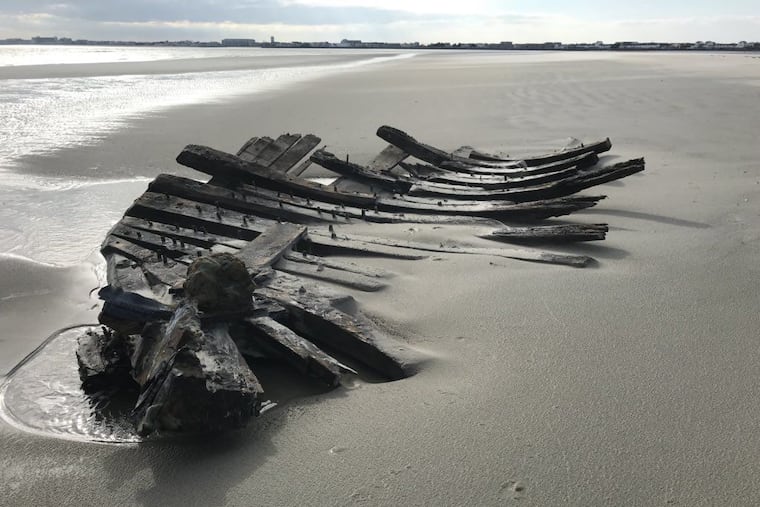Discovery of shipwreck at the Jersey Shore fuels debate: Which boat is it?
The mysterious wreckage found in Stone Harbor earlier this month could be one of the ships long lost at sea when the Hereford Inlet was filled with cargo ships in the 1700s and 1800s.

Crashing waves from a storm exposed the skeletal remains of a centuries-old ship in Stone Harbor earlier this month and fueled debate among historians about the vessel’s origins and its place in the fantastical lore of the Shore.
The heavy oak ribs, wooden pins, and copper nails are mere clues to the 25-foot skeleton that once belonged to a larger vessel. Historians say it likely sank in the early 1800s — or even 1700s — in the Hereford Inlet, which separates Wildwood and Stone Harbor.
Could it be the D.H. Ingraham, a schooner that capsized in 1886? Or, is it the Mexican Guatimozin, with a stash of gold coins worth $100,000 when it sank in 1801? The gold, hidden amid a cargo of tea, was on its way to the Philadelphia banker and philanthropist Stephen Girard. It has never been found.
“We may never know,” says historian Steve Murray, chairman of the nonprofit Friends of the Hereford Inlet Lighthouse in Cape May County. He’s betting on the Ingraham. James Talone, president of the Stone Harbor Museum, points out that Girard’s gold sank in the same area as the Ingraham.
There were about 100 wrecks throughout the inlet. It is known as a treacherous waterway at the southern tip of Stone Harbor where the bay meets the ocean, sands constantly shift, and the inlet floor drastically changes. Back then, ships ran aground as nor’easters blew the sails toward land and waves tipped the vessels like the one unearthed in recent weeks.
Bundled in winter coats and smartphones in hand, the curious have hiked to the three-mile stretch of the Stone Harbor Point where locals discovered the find in mid-December.
Zeke Orzech, a surfer/dad/weather geek, posted a Dec. 20 photo on Twitter that read: “This is cool!! A shipwreck has emerged from the sand at the point in #StoneHarborNJ”
On Friday, Orzech, who lives in Cape May Court House and is a house painter, said he heard about the wreckage from his boss and like many others wanted to see it. He hesitated before posting on Twitter a picture of the remote beach, knowing that it would become an attraction and that others could tear it apart. But he posted because “it was so neat you want people to see it.”
He’s been living year-round at the Jersey Shore for three decades and this is among the unique things he has seen, especially as it has sparked speculation that the vessel could be the D.H. Ingraham. The Maine schooner sank in 1886 on its way to Richmond, Va. The five-man crew nearly went down with a cargo of the mineral lime that caught fire in a blinding winter storm. Crew members were famously saved by coastal station employees who launched a rescue boat and plucked the men as the burning ship capsized.
Murray has researched and written about the Ingraham. When he learned about the wreckage, he conducted his own inspection. Not only was the wreckage found in the same area where the Ingraham sank, but the ribs looked charred.
“That’s pretty good evidence,” he said.
It could be that ship, but Talone, who also inspected the wreckage, says he measured the ribs at 14 feet from tip to tip, and eight to 10 inches thick. The Ingraham was a larger schooner, he thinks.
“Mostly, it’s a mystery,” he posted on the Stone Harbor Museum Facebook page under the heading “The Unnamed Wreck.”
J.P. Hand, author of The Cape May Navy, said it’s premature to say which ship has been found.
“I think it is safe to say at this time that we don’t know which vessel it is,” said Hand, whose family was among the early Cape May settlers.
Unless a donor turns up, there are no plans to try to save the wreck.
“Ideally, it would be nice if it could be put on display and preserved. If not, I’d like to see it buried at sea again,” said Murray, who hoped scavengers would not pick it apart for keepsakes. “It was preserved pretty well.”